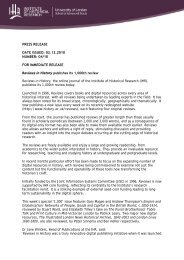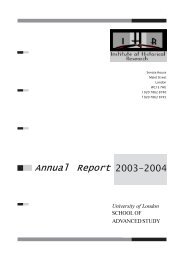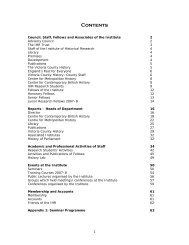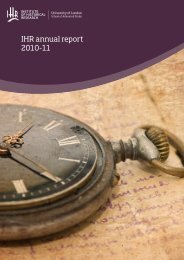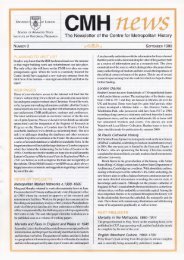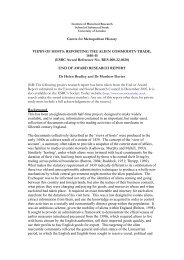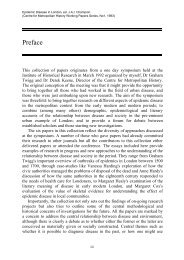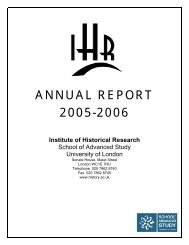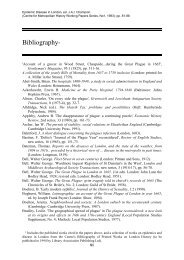CMH AnnuAl RepoRt 1999â2000 - Institute of Historical Research
CMH AnnuAl RepoRt 1999â2000 - Institute of Historical Research
CMH AnnuAl RepoRt 1999â2000 - Institute of Historical Research
Create successful ePaper yourself
Turn your PDF publications into a flip-book with our unique Google optimized e-Paper software.
Metropolitan Market Networks<br />
No. <strong>of</strong> debts<br />
10<br />
5<br />
1<br />
1570<br />
Fig 1. Debts owed to Londoners in 1329, 1424 and 1570<br />
From cases in the court <strong>of</strong> Common Pleas. The sample for 1329 is small, but enlarging it by taking<br />
account <strong>of</strong> pleas <strong>of</strong> account (which at that date indicate commercial contact in the same way as<br />
pleas <strong>of</strong> debt) does not significantly alter the picture. The expansion, by 1424, <strong>of</strong> London’s sphere<br />
<strong>of</strong> influence as a supplier <strong>of</strong> goods and credit is very striking. By 1570 it is apparent that London’s<br />
contact with coal-producing areas in the North East and with textile producing areas in Yorkshire<br />
and in Wiltshire and Somerset had sharply increased, while direct contact with the city <strong>of</strong> York and<br />
with Devon and Cornwall had diminished (for different reasons in each case).<br />
century, when volatility again increased. Both the rural and urban economies <strong>of</strong><br />
Devon performed well in the fifteenth century — real improvements in market<br />
organisation may have been associated with this prosperity.<br />
The apparently growing detachment <strong>of</strong> Exeter from a London-focused economy<br />
between 1424 and 1570 revealed by analysis <strong>of</strong> debt cautions against generalising<br />
from the Exeter data alone. Analysis <strong>of</strong> fifteenth-century prices from London<br />
(Westminster), Canterbury and Chester suggests that Exeter’s decline in volatility<br />
was shared by other southern markets, but that in the north-west the picture<br />
may have been very different. The movement <strong>of</strong> prices in later fifteenth-century<br />
Chester appears more violent and erratic than at any <strong>of</strong> the other locations,<br />
which may, in the absence <strong>of</strong> clear evidence for changing measures or other



